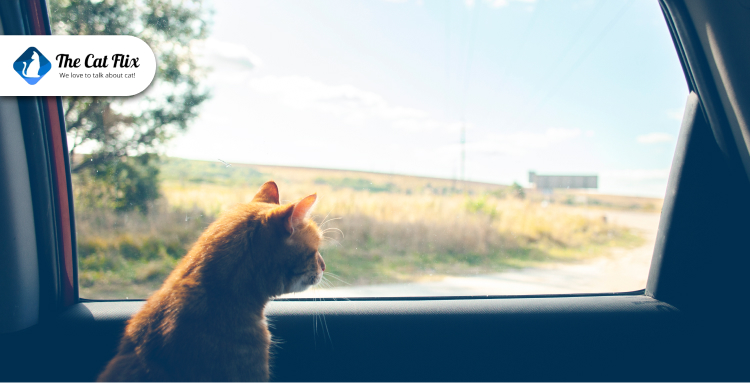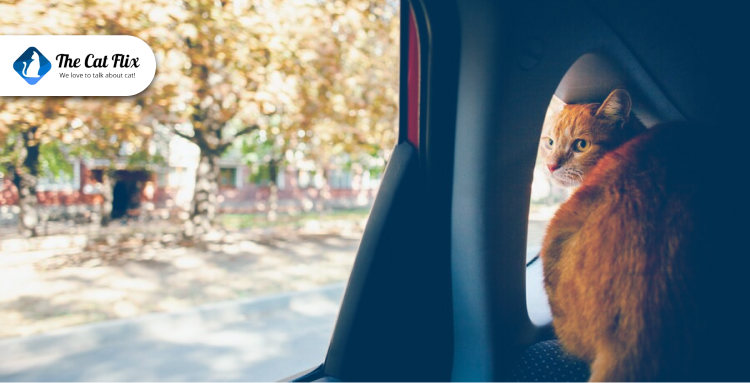There’s something strangely unsettling about the open road when you’re not traveling alone. A silent passenger, tucked away in their carrier, stares out into the unknown—a little creature caught between instinct and a world they didn’t choose.
Your cat doesn’t understand the hum of the tires or the ceaseless motion that feels like a cage. For them, a car ride isn’t an adventure; it’s an enigma, a force that unsettles their body and spirit. They might meow endlessly, drool, or worse. And as much as you might love the idea of bringing them along, the reality is fraught with discomfort for them and, let’s be honest, for you too.
But what if it didn’t have to be this way? What if the journey could be as serene as a cat curled up in a sunlit window? Let’s start there—with the idea that, with a little care and understanding, even the most car-sick feline can find their peace on the road.
1) Recognizing Cat Car Sickness: Symptoms and Causes
Cats, as enigmatic as they are, rarely announce their discomfort outright, leaving us to decode their behavior like a plot twist in a Christopher Nolan movie.
(i) Symptoms to Watch For
- Drooling: This isn’t the contented purring drool you might see when they’re basking in a sunbeam. In a car, excessive drooling often signals nausea.
- Lethargy: A typically curious and alert cat suddenly becoming listless during a drive could be dealing with motion sickness.
- Vomiting: Perhaps the most unmistakable sign, vomiting is your cat’s physical reaction to an internal imbalance caused by the car’s motion.
- Excessive Meowing or Agitation: While some cats are naturally chatty, frantic meowing or attempts to escape their carrier could point to distress.
- Refusal to Eat or Drink: If your cat turns its nose up at food or water before or during the trip, it could be battling nausea or stress.
(ii) Motion Sickness vs. Anxiety: The Subtle Difference
It’s important to determine whether your cat’s symptoms stem from anxiety or motion sickness—they’re not the same, though they often overlap like a Venn diagram of feline woes.
- Motion Sickness: Much like humans, cats can experience disorientation when their inner ear (responsible for balance) struggles to align with the car’s movement. This physical reaction typically leads to nausea and vomiting.
- Anxiety: On the other paw, anxiety is more psychological. They may associate car rides with negative experiences, much like how we dread a trip to the DMV. This can trigger agitation, vocalizations, or a refusal to enter the carrier.
2) Pre-Trip Preparations for Cat Travel

Preparing your cat for a road trip isn’t unlike prepping for a red carpet debut—it takes thoughtful planning, patience, and the right accessories.
- Gradual Acclimation: Baby Steps to Road Trip Glory
Cats aren’t natural road warriors; they’re more like introverts at a networking event—wary and hesitant. Start with short drives around the block to help your cat adjust. These brief outings are the feline equivalent of dipping a toe into the pool before diving in.
Gradually increase the duration of your trips, making each outing a positive experience. Bring along treats, soothing music (classical piano, not heavy metal), or even a comforting voice. Over time, they’ll learn to associate the car with something other than dread—like Taylor Swift learning to embrace the spotlight.
-
Feeding Tips: Keep It Light
Just as you wouldn’t indulge in a three-course meal before hitting a roller coaster, your cat’s pre-travel diet matters. Avoid feeding them large meals 4-6 hours before the trip. This prevents nausea and reduces the risk of vomiting.
Going the extra mile, pack small portions of their favorite snacks for postride recovery. Think of it as their version of a post-flight lounge snack—comforting and familiar.
-
The Right Carrier: A Safe Haven on Wheels
Your cat’s carrier is more than a travel accessory; it’s their mobile fortress of solitude. Opt for a sturdy, well-ventilated model with enough space for them to stretch but not so much that they slide around. Line it with their favorite blanket or cushion—something that smells like home, like their very own Ted Lasso pep talk in fabric form.
Place the carrier in a secure spot in your car, such as the floor behind the front seats, to minimize movement. Avoid the passenger seat unless it can be safely strapped in, as airbags pose a risk to pets.
3) Create a Comfortable Car Environment for Your Cat

Cats may not appreciate the allure of a road trip playlist or scenic views, but they can certainly feel the difference in a thoughtfully prepared environment.
-
Maintaining a Comfortable Temperature: The Goldilocks Zone
Cats are connoisseurs of coziness, so the car’s temperature must be just right—not too hot, not too cold. Keep the cabin in a moderate range, typically between 70°F and 75°F, to ensure your feline feels at ease.
Avoid placing the carrier in direct sunlight, as cats can overheat quickly, much like an unguarded ice cream cone on a summer day. If you’re traveling in colder weather, ensure the car is adequately warmed before setting off. Remember, this isn’t Frozen—no cat wants to “let it go” and freeze in the process.
-
Securing the Carrier: Stability Equals Serenity
A secure carrier is your cat’s ultimate safe space, but it loses its charm if it’s jostling around like a grocery bag in the trunk. Place the carrier on the floor of the back seat or behind the passenger seat, where it’s least likely to be affected by motion. Use seat belts or specialized carrier straps to keep it firmly in place.
Think of it as giving your cat the VIP treatment—no turbulence, no chaos, just smooth sailing. Even the Fast & Furious crew would approve of this level of care for their furry passengers.
-
Reducing External Stimuli: A Peaceful Retreat
Cats aren’t big fans of overstimulation, and the constant blur of passing scenery can be as disorienting as a Christopher Nolan film plot. Drape a light blanket or cover over the carrier to create a private, calming space.
This cover acts as a visual buffer, shielding your cat from triggers while still allowing for proper ventilation. It’s essentially their version of slipping on a sleep mask during a long-haul flight—instantly calming and a clear signal that it’s time to relax.
4) Use Calming Aids to Help Your Cat Relax During Travel

Sometimes, even the most luxurious accommodations and careful preparations can’t soothe a stressed-out cat. For those moments, calming aids become your secret weapon—think of them as the Doctor Strange of road trips: a little magic to restore balance to the universe (or your car).
-
Pheromone Sprays: A Scent of Serenity
Pheromone sprays, like Feliway, mimic the natural calming chemicals cats produce when they feel safe and secure. A few spritzes inside the carrier can transform it from a perceived dungeon to a cozy retreat.
It’s subtle, scentless to humans, and surprisingly effective—like the cat version of aromatherapy. Think of it as the Marie Kondo of feline stress: it sparks joy, or at least diminishes existential dread.
-
Herbal Remedies: Nature’s Soothing Touch
For a natural approach, herbal remedies like catnip, valerian root, or chamomile can work wonders. Catnip, in particular, often gets a bad rap for its party-animal effect, but for some cats, it actually has a calming, almost meditative quality.
Valerian root is another popular choice, known for its mild sedative properties. These options are like serving your cat a warm cup of chamomile tea before bed—a little indulgence to ease their nerves. However, every cat reacts differently, so test these remedies at home before the big trip.
-
Prescription Medications: For the Toughest Cases
If your cat’s stress levels rival those of a Game of Thrones finale viewer, it might be time to consult your veterinarian. Prescription medications like anti-nausea pills (e.g., Cerenia) or mild sedatives can provide relief for severe motion sickness or anxiety.
Read our other related article to keep your feline friend happy and healthy :
How to Pamper Your Senior Cat Like a Pro: Essential Tips
If your cat ate something toxic, what should you do?
Dealing with an aggressive cat? Tame this behavior with these easy tips.
5) Planning Long Road Trips with Your Cat: Breaks, Safety, and Comfort

Cats, being creatures of habit, thrive on predictability—even when the adventure stretches beyond their usual nap-to-play ratio.
-
Frequent Breaks: A Breather for Your Feline Star
Just as you’d pause during a road trip to stretch your legs and grab a coffee, your cat needs breaks to recover from the unfamiliar motion of the car. Aim to stop every 2-3 hours to let your feline decompress.
For these breaks, keep the carrier securely closed and bring it into a safe, enclosed space if possible—this could be a quiet corner of a rest area or even inside the car with the engine off. Remember, your cat isn’t here for the fast and furious vibes; they’re more of a “pause and reflect” traveler.
During breaks, offer water to keep them hydrated and check their comfort levels. Avoid overfeeding; a few kibbles or a light snack can suffice, much like a protein bar on a road trip for humans.
-
Safety Precautions: Keep Things Secure
When stopping, prioritize your cat’s safety above all else. Never open the carrier outdoors unless you’re in a fully enclosed area—cats are quick, and even the most docile ones can bolt if spooked. Portable pet pens or pop-up enclosures designed for travel are ideal for safe stretching sessions.
Think of these stops as carefully orchestrated intermissions, like a break during a Broadway performance—structured, necessary, and respectful of your star’s needs. Ensure your car is locked if you leave it briefly, but never leave your cat alone in a hot or cold vehicle. Even if you think, “I’ll only be a minute,” remember: it’s not worth the risk.
Paws on the Road, Peace in the Carrier
Traveling with a cat is, in many ways, an act of love. It’s a choice to bridge the gap between their comfort and your desire to share life’s adventures with them. The road may be bumpy, and the journey may test your patience, but in these small moments—when their trust in you outweighs their fear—you find a kind of quiet triumph.
To those who’ve stayed with us, paw in hand, remember: you’re not just taking a trip; you’re building a bond. The care and thought you put into their journey speak volumes, even if your cat’s only response is a subtle purr or a nap in the carrier corner.
And if this resonates with you, dear reader, know you’re among kindred spirits here at The Catflix. We’re about celebrating the complex, quirky love we share with our feline friends. Stick around for more insights and helpful tips on keeping your cat happy and healthy, whether at home or on the move.

